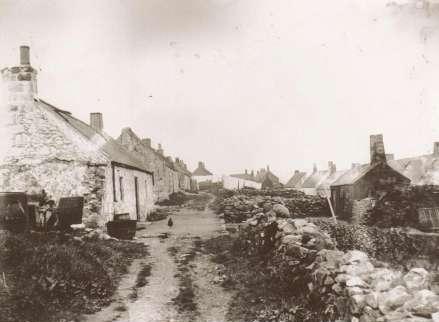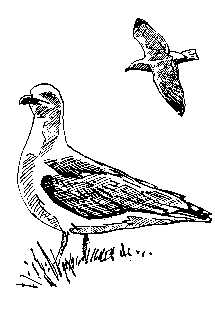
Herring Gull |
The mainstay of the seabird population in our area is the Herring Gull, or the Pling as it is known locally. These are the ones that tend to rip open our bags of rubbish, snatch a sandwich from our hands, and more recently have developed a penchant for stealing packets of crisps from our shops! It wasnít always this way and itís only within the last thirty years that the Herring Gull has become something of an urban pest.
In the
past the Herring GullĎs territory was mainly coastal, with forays inland
when there was any agricultural ploughing going on. Of course they have
always been a common sight in our coastal cities, particularly those
with large harbours and fish markets but their habitat and nesting sites
tended to be on or around the cliffs and rocks and itís only in recent
years that they have started breeding on buildings within our towns and
cities.
was any agricultural ploughing going on. Of course they have
always been a common sight in our coastal cities, particularly those
with large harbours and fish markets but their habitat and nesting sites
tended to be on or around the cliffs and rocks and itís only in recent
years that they have started breeding on buildings within our towns and
cities.
In years gone by the eggs of the Herring Gull were collectable as they were very popular as an ingredient for baking and in some instances they were considered a delicacy to eat on their own. They were free too which was another reason why they would have been popular to the thrifty folks of north east Scotland.
 In the
1970ís and for many years before that it was possible to walk down to
Portlethen Shore, make your way south towards
Downies, above the high
water mark and below the cliffs, and you would find your first nest of
Herring Gullís eggs within 50 yards of leaving the shore. As most nests
contained two or three eggs it was possible to collect over 200 eggs by
the time you reached Downies, and that tally was possible without having
to attempt to reach the nests that were perched on the more inhospitable
areas.
In the
1970ís and for many years before that it was possible to walk down to
Portlethen Shore, make your way south towards
Downies, above the high
water mark and below the cliffs, and you would find your first nest of
Herring Gullís eggs within 50 yards of leaving the shore. As most nests
contained two or three eggs it was possible to collect over 200 eggs by
the time you reached Downies, and that tally was possible without having
to attempt to reach the nests that were perched on the more inhospitable
areas.
So what do you do with 200 eggs? You take them home, put them in a large bucket filled with isinglass, a gelatine solution, leave them there and remove them as and when they are required for baking or eating. The chick embryo doesnít develop and the preservative nature of the solution saves the eggs from rotting and they stay fresh for a matter of months.
Of course nowadays wild birdís eggs are protected and I imagine that it would be illegal to remove Gullís eggs to try this out; not that many people today would feel that their appetite has been whetted enough to put this to the test. In the past though, a Gullís egg was something of a necessity as well as being very popular amongst the locals, in fact it was common every year to read headlines in the local newspapers about someone that had died or been seriously injured in a fall whilst collecting gullís eggs in our area.
 What do
Gullís eggs taste like? As you would expect they are a bit salty and
fishy and this would have been more noticeable in those eggs that were
eaten on their own. I donít think Iíve eaten a Gullís egg by itself, or
if I did I was too young to remember, but I have definitely sampled some
baked rock cakes where gullís eggs were one of the main ingredients and
they were very palatable.
What do
Gullís eggs taste like? As you would expect they are a bit salty and
fishy and this would have been more noticeable in those eggs that were
eaten on their own. I donít think Iíve eaten a Gullís egg by itself, or
if I did I was too young to remember, but I have definitely sampled some
baked rock cakes where gullís eggs were one of the main ingredients and
they were very palatable.
Today during nesting season if I take that same walk and climb from Portlethen Shore to Downies, I would be lucky to see a dozen gullís eggs during my journey. In the past the Herring Gull wasnít too choosy where it built its nest and it was just as likely that you would find one lying flat on the foreshore as it was to find one on a precarious cliff edge. That is not the case nowadays and with few exceptions the only places around Portlethen and Downies where you are likely to find large colonies of Herring Gullís nesting are ďMay CraigĒ, north of Portlethen Shore and near the ďKnaps of DowniesĒ at Downies Haven, both areas that are generally only accessible by boat.